![]()
![]()
![]()
Use LEFT and RIGHT arrow keys to navigate between flashcards;
Use UP and DOWN arrow keys to flip the card;
H to show hint;
A reads text to speech;
113 Cards in this Set
- Front
- Back
|
Branches of Phonetics |
acoustic (sound transmission) auditory (sound perception + processing) articulatory (sound production -> linguistics) |
|
|
voiced and voiceless consonants |
voiced: vibrating - airflow coming through the windpipe voiceless: no vibrating |
|
|
Manner of Articulation: obstruents |
airflow is strongly obstructed
plosive (stop): airstream is blocked due to two articulators touching each other, air is built up in the vocal tract and suddenly released [p], [t], [k]
fricative: continuous stream of air passes through a narrow opening, produces friction and a hissing sound [f], [s], [ʃ]
affricate: combination of a plosive and a fricative; airstream is completely blocked, air is built up, which is then released (like a plosive) and continued (like a fricative) [tʃ], [dʒ] |
|
|
Manner of Articulation: Sonorants |
usually voiced nasal: by lowering the velum the air passes out through the nasal cavity [m], [n] approximant: articulators touch or approach each other without audible friction -> liquid [l], [r] -> semi-vowel [w], [j] |
|
|
[p] |
voiceless bilabial plosive |
|
|
[b] |
voiced bilabial plosive |
|
|
[t] |
voiceless alveolar plosive |
|
|
[d] |
voiced alveolar plosive |
|
|
[k] |
voiceless velar plosive |
|
|
[g] |
voiced velar plosive |
|
|
[f] |
voiceless labiodental fricative |
|
|
[v] |
voiced labiodental fricative |
|
|
[θ] |
voiceless dental fricative |
|
|
[ð] |
voiced dental fricative |
|
|
[s] |
voiceless alveolar fricative |
|
|
[z] |
voiced alveolar fricative |
|
|
[ʃ] |
voiceless palatoalveolar fricative |
|
|
[ʒ] |
voiced palatoalveolar fricative |
|
|
[h] |
voiceless glottal fricative |
|
|
[tʃ] |
voiceless palatoalveolar affricate |
|
|
[dʒ] |
voiced palatoalveolar affricate |
|
|
[m] |
voiced bilabial nasal |
|
|
[n] |
voiced alveolar nasal |
|
|
[ŋ] |
voiced velar nasal |
|
|
[l] |
voiced alveolar liquid |
|
|
[r] |
voiced post-alveolar liquid |
|
|
[w] |
voiced bilabial semi-vowel |
|
|
[j] |
voiced palatal semi-vowel |
|
|
Vowels |
air passes through the oral cavity relatively freely generally voiced |
|
|
Vowel Diagram |
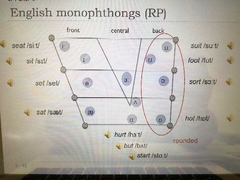
Height of the Tongue: high, mid, low
Part of the Tongue: front, central, back
Lip rounding: rounded vs unrounded
Vowel length: how long the tongue remains in a particular position: short (lax) or long (tense)
|
|
|
Monophthongs |
tongue stable |
|
|
Diphthongs |
tongue glides closing (ending in [ɪ], [ʊ]) centering (ending in schwa-sound [ə]) |
|
|
Transcription |
Representing sounds (pronunciation) in writing orthography =/= pronunciation -> different spelling for same sounds -> same spelling for different sounds |
|
|
phonetics vs phonology |
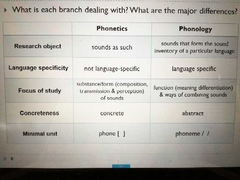
|
|
|
Phonemic transcription |
captures as many aspects of a specific pronunciation as possible using diacritics |
|
|
Phonemic transcription |
ignores as many details as possible; captures only enough aspects of a pronunciation to show how that word differs from other words in the language |
|
|
Weak vowels |
only in unstressed syllables [i] happy [u] situation [schwa] helpless |
|
|
closing diphthongs |

|
|
|
centring diphthongs |
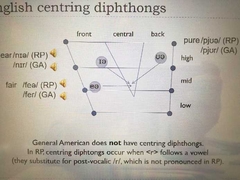
|
|
|
phoneme |
smallest meaning-distinguishing unit of a language |
|
|
morpheme |
smallest meaning-bearing unit of language {SING} |
|
|
Morphology |
- internal structure of words - processes that allow us to create -> new lexemes/words (word formation, derivation...) -> forms by encoding grammatical meaning (inflection) |
|
|
types of morphemes |
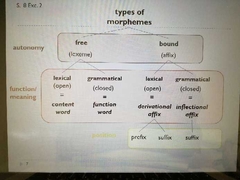
|
|
|
types of morphemes 2 |
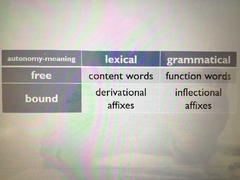
|
|
|
free morpheme |
{DOG} {THE} |
|
|
bound morpheme |
{-MENT} {-ER} |
|
|
Free, lexical morpheme |
{DOG} |
|
|
Free, grammatical morpheme |
{THE} |
|
|
Bound, lexical morpheme (derivational) |
{-MENT} |
|
|
Bound, grammatical morpheme (inflectional) |
{-ER} |
|
|
derivation |
attach lexical morphemes
word formation (-> word class change) |
|
|
inflection |
attack grammatical morphemes grammatical meanings |
|
|
8 types of inflectional morphemes |
{PLURAL} {POSSESSIVE} {3RD SG. IND. PRESENT} {PAST} {PRES. PART} {PAST PART} {COMPARATIVE} {SUPERLATIVE} |
|
|
Morphophonemics/Morphophonology |
interface between morphology and phonology morphemes are abstract linguistic signs that have a meaning (e.g. {PLURAL}) and a phonological form the actual phonological form of a morpheme can vary |
|
|
Allomorph |
Different concrete phonological realisations of the same morpheme |
|
|
Allophone |
Different concrete phonetic realisations of the same phoneme |
|
|
{PLURAL} allomorphs |
/-ɪz/ after sibilants /z/, /s/, sh, etc /-z/ after other voiced consonants /-s/ after other voicel. consonants
|
|
|
Zero allomorph |
{PLURAL} allomorph in sheep, sheep + Ø |
|
|
{PAST} allomorphs |
/-ɪd/ after alveolar plosives /-d/ after other voiced sounds /-t/ after other voicel. consonants |
|
|
Base allomorphy |
Sometimes an inflection changes the base of a lexeme wife-wives weep-wept good-better |
|
|
{3RD PERS SG PRES} allomorph |
/-ɪz/ after sibilants /-z/ after other voiced sounds /-s/ after other voiceless sounds |
|
|
Suppletion |
after inflection: forms do not resemble each other, nor are they etymologically related |
|
|
phonological conditioning |
/-ɪz/, /-z/, /-s/ |
|
|
lexical conditioning |
allomorph is restricted to individual lexemes ox-oxen sheep-sheep |
|
|
grammatical conditioning |
base allomorphy: addition of a grammatical morpheme changes base morpheme weep-wept |
|
|
3 stages of new lexeme formation |
- Nonce/ad hoc formations - Institutionalisation - Lexicalisation |
|
|
Derivation by affixation |
Lexeme (free lexical morpheme) + bound lexical morpheme = new lexeme prefixation and suffixation |
|
|
Compounding |
stringing together of two or more free lexical morphemes to one complex free morpheme, the compound |
|
|
4 semantic types of compounds |
- endocentric: modifier + head airsick, living room, ready-made - exocentric: head refers to implied meaning redneck - appositional: head + head actor-director - copulative: head + head bittersweet |
|
|
Conversion |
Derivation without affixation
noun -> verb: to bottle, to butter
adjective -> verb: to better, to calm
word formation or syntax (ellipsis)? verb -> noun: a cough, a coverword formation or syntax (ellipsis)? adjective -> noun: the poor (people), a daily (newspaper) adjective -> noun: the poor (people), a daily (newspaper) Modelled as zero-derivation: - a bottle + Ø -> to bottle |
|
|
5 types of shortenings |
clippings: part of a word is omitted ad, app, mic, phone, flu blends: two words are merged sitcom, Brangelina, spork acronyms: initialisms that are pronounced like words NATO, laser, asap, radar alphabetisms: initialisms that are pronounced letter by letter CD, PC, YMCA, tba back-formations: result of taking away a real or putative derivational suffix, resulting in a base that did not exist before television - televize contraception - contracept |
|
|
Semantics |
Study of meaning (of words, phrases, sentences) |
|
|
Semantics relation to other branches of linguistics |
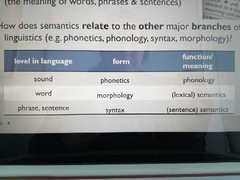
|
|
|
Denotation |
The (abstract) class of objects to which the term can be potentially applied. |
|
|
Connotation |
The (affective or emotional) associations a lexeme elicits or the attitudes a particular lexeme conveys (as opposed to another lexeme with roughly the same denotation). Not necessarily shared by all speakers of a language, but above the level of idiosyncratic variation. |
|
|
Syntagmatic Relations |
hold between items which occur in the same sentence |
|
|
Paradigmatic Relations |
reflect the semantic choices available for a particular syntactic slot in a sentence |
|
|
Lexical/semantic fields |
groups of words which cover different (or partly overlapping - > semantically ambiguous) areas within the same extralinguistic domain -> members of a semantic field are in a paradigmatic relationship |
|
|
Onomasiology |
function - expression |
|
|
Semasiology |
expression - function |
|
|
Expressive meaning |
attached feelings, evaluations, opinions, speaker judgments |
|
|
Descriptive meaning |
conceptual: (cognitive) content ('image') a lexeme evokes |
|
|
Social meaning |
meaning components that convey or signal social information/statuses: a) area of discourse (technical VS everyday vocabulary) b) channel (spoken vs written, e-mail, twitter) c) style (formal, neutral, informal) d) dialects/regiolects |
|
|
Paradigmatic Sense Relations |
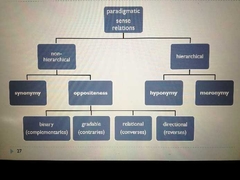
Refers to the relations that hold between one sense of a lexeme and the/a sense of another lexeme (especially regarding choices inside semantic fields) |
|
|
Synonymy |
Semantic equivalence or extensive semantic similarity -> descriptive synonymy: interchangeability in many but not all contexts - connotations - style/register - regional/social - collocations -> total synonymy: interchangeability in all contexts |
|
|
Antonymy & Oppositeness |
binary antonyms (complementaries) either-or relationship asleep - awake dead - alive converses/relational opposites same situations from different perspectives teacher - pupil older - younger give - take gradable antonyms (contraries) opposite poles of a continuum hot - cold old - young male - female directional opposites/reversives involve a change of direction (especially motion in different directions) open - shut push - pull button - unbutton |
|
|
Hyponym |
subordinate term |
|
|
Hyperonym |
superordinate term |
|
|
Heteronyms (Co-Hyponymy) |
words on the same hierarchical level |
|
|
Hyponymy |
is-a sub/superordinate relationship |
|
|
Meronymy |
has-a/part-whole relationship |
|
|
Meronym |
part of something |
|
|
Holonym |
the whole |
|
|
Monosemy |
If a lexeme has one descriptive meaning (sense), it is monosemous |
|
|
Polysemy |
Lexemes that have more than one descriptive meaning (multiple senses) (=members of more than one lexical field with distinct sense relations) |
|
|
Homonymy |
same pronunciation + spelling |
|
|
Homophony |
same pronunciation + different spelling |
|
|
Homography |
same spelling + different pronunciation |
|
|
Polysemy vs Homonymy |
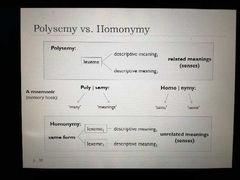
|
|
|
Types of Morphemes |
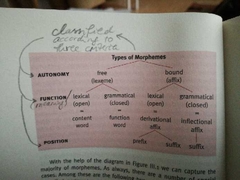
|
|
|
Sentence constiuents |
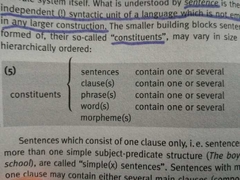
|
|
|
Sense relations |
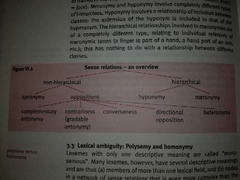
|
|
|
Homonymy |
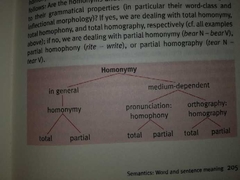
|
|
|
Semantics vs Pragmatics |

|
|
|
Deictic dimensions |
person, place, time |
|
|
further types of deictic expression |
social, discourse, manner and degree |
|
|
Types of Deixis |
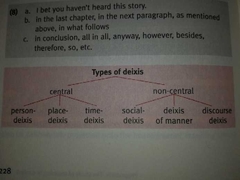
|
|
|
Use of deictic expression |

|
|
|
Illocutionary acts |
-Assertives or representatives are used to describe the world (e.g. state, express, claim, tell,...) -Directives are attempts to get people to do things (e.g. give an order, ask something) -By means of commissives speakers commit themselves to a future action which will change the world in some way (e.g. by promising, threatening) -We use expressives to express our feelings and opinions; offer a glimpse of the hearer's psychological state (e.g. thank, greet, congratulate, apologize, complain) -Declarations essentially serve to bring about a new external situation; they show that the world can indeed be changed by language (e.g. baptisms, marriages, divorces, declarations of war); requires extra-linguistic institutions |
|
|
3 major sentence types |
declarative, interrogative, imperative |
|
|
Grice's Cooperative Principle |

|
|
|
Types of inferences |

|
|
|
Morphology |
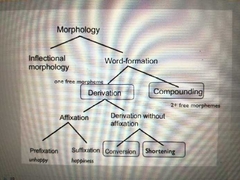
|

